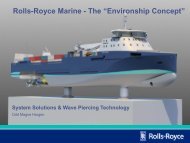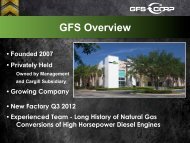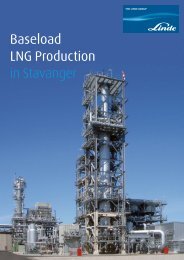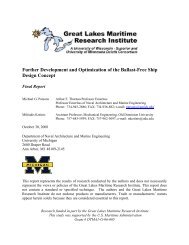15 MB - Great Lakes Maritime Research Institute
15 MB - Great Lakes Maritime Research Institute
15 MB - Great Lakes Maritime Research Institute
You also want an ePaper? Increase the reach of your titles
YUMPU automatically turns print PDFs into web optimized ePapers that Google loves.
OEM manufacturer should be consulted to verify compatibility and ensure enginewarrantees will be honored. Biodiesel blends up to B20 have been used in older engineswithout any observed fuel system component degradation. However, a prudent course ofaction would be to upgrade fuel system components if B20 is to be used. Because it is asolvent, B100 will remove deposits left in the fuel system by petroleum diesel, which canlead to clogged fuel filters. When switching directly from petroleum diesel to B100, fuelfilters should be checked and cleaned frequently until the fuel system deposits areremoved. Blends as high as B20 have not shown the same tendency to remove fuelsystem deposits, however, more frequent checking and cleaning of the fuel filters shouldstill initially be performed.Engine operation in cold weather can be problematic due to the higher cold flowproperties associated with B100. As a precaution, B100 should not be used withoutheated fuel tanks and fuel lines if the temperature is below 40°F. This is a conservativeestimate since the “average” cloud point of B100 is 32°F as compared to 3°F for #2diesel. Blends up to B20 can be used in environments with temperatures approaching theoperational temperature for the distillate used in the blend. For example, the cloud pointof #2 diesel is 3°F, and when B20 is produced with #2 diesel, the cloud point isapproximately 7°F. The solutions for avoiding fuel gelling when using B100 or abiodiesel blend (such as B20) are the same as those for #2 diesel. Namely, blend with #1diesel, use a fuel line heater, keep the engine and fuel lines in an environmentallycontrolled space, and use cold flow enhancing fuel additives.2.4.4 <strong>Maritime</strong> UsageBiodiesel blends up to approximately B20 can be used as direct replacements for dieselpowered equipment on maritime vessels that utilizes #2 diesel with little or nomodification to current systems. The use of a B20 blend will allow for measurablereductions in emissions with no noticeable decrease in fuel economy. Many OEM enginemanufacturers currently certify the use of up to B5 in their engines as long as both thebiodiesel and the distillate portion of the blend meet ASTM specifications. ASTMInternational is currently working with OEM engine manufacturers to create a B20standard for engine certification tests. Main engines that operate on heavy fuel oils orBunker C are not candidates for the use of B20.Examples of ship board systems that currently use #2 diesel include, the main engines onships with EMD diesels, dieselgenerator sets, emergency generators, and deck cranepower packs. The specific engines that power these systems, as well as the makeup ofthe systems themselves, vary from ship to ship. Some components, such as the deckcrane power packs, have fuel systems exposed to ambient weather conditions, while othercomponents, such as the dieselgenerator sets, have fuel system components inenvironmentally controlled spaces. As a result, no single set of rules for converting toB20 usage can be delineated, and the general rules for dealing with the issues discussedin the preceding section should be applied to each system on each ship.11












